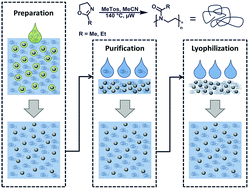当前位置:
X-MOL 学术
›
J. Mater. Chem. B
›
论文详情
Our official English website, www.x-mol.net, welcomes your
feedback! (Note: you will need to create a separate account there.)
Mission ImPOxable – or the unknown utilization of non-toxic poly(2-oxazoline)s as cryoprotectants and surfactants at the same time
Journal of Materials Chemistry B ( IF 6.1 ) Pub Date : 2017-11-01 00:00:00 , DOI: 10.1039/c7tb02443f Meike N. Leiske 1, 2, 3, 4, 5 , Anne-Kristin Trützschler 1, 2, 3, 4, 5 , Sabine Armoneit 3, 4, 6 , Pelin Sungur 1, 2, 3, 4, 5 , Stephanie Hoeppener 1, 2, 3, 4, 5 , Marc Lehmann 3, 4, 6 , Anja Traeger 1, 2, 3, 4, 5 , Ulrich S. Schubert 1, 2, 3, 4, 5
Journal of Materials Chemistry B ( IF 6.1 ) Pub Date : 2017-11-01 00:00:00 , DOI: 10.1039/c7tb02443f Meike N. Leiske 1, 2, 3, 4, 5 , Anne-Kristin Trützschler 1, 2, 3, 4, 5 , Sabine Armoneit 3, 4, 6 , Pelin Sungur 1, 2, 3, 4, 5 , Stephanie Hoeppener 1, 2, 3, 4, 5 , Marc Lehmann 3, 4, 6 , Anja Traeger 1, 2, 3, 4, 5 , Ulrich S. Schubert 1, 2, 3, 4, 5
Affiliation

|
Polymer based nanoparticles offer great opportunities for diverse applications, i.e. their drug delivery potential is promising. However, their major drawback is identified in preparation via the nanoemulsion technique, which is needed for the encapsulation of hydrophilic drugs and whereby the utilization of surfactants, e.g. poly(vinyl alcohol) (PVA), is mandatory. Furthermore, the preparation of nanoparticles is critical due to the need of lyophilization for storage. For this reason it is common to use cryoprotectants, which are usually sugar based. In the current study, we present the use of non-toxic, water-soluble poly(2-oxazoline)s (P(Ox)s) in terms of polymeric nanoparticle stabilizers for preparation, purification, and lyophilization. The nanoparticles were characterized via dynamic light scattering (DLS) and cryo-transmission electron microscopy (cryoTEM). The use of hydrophilic P(Ox)s with a degree of polymerization of about 60 yielded stable nanoparticles. For the preparation via nanoemulsion a PDI below 0.2 could be obtained after adjustment of the surfactant concentration. All nanoparticles were in the size range of 100 to 200 nm according to DLS. Furthermore, the addition of P(Ox) was beneficial during particle purification via centrifugation and filtration as well as lyophilization, yielding nanoparticles with a PDI below 0.3 as determined via DLS and confirmed via cryoTEM measurements. Cytotoxicity, hemolysis and erythrocyte aggregation measurements of these P(Ox)s did not show any harmful effect on the treated cells.
中文翻译:

任务无害–或未知同时使用无毒的聚(2-恶唑啉)作为冷冻保护剂和表面活性剂
基于聚合物的纳米颗粒为多种应用提供了巨大的机会,即它们的药物输送潜力是有前途的。然而,它们的主要缺点是在通过纳米乳剂技术制备时发现的,这对于封装亲水性药物以及利用表面活性剂(例如表面活性剂)是必需的。聚乙烯醇(PVA)是强制性的。此外,由于需要冷冻干燥来储存,纳米颗粒的制备至关重要。因此,通常使用通常基于糖的防冻剂。在当前的研究中,我们目前就聚合物纳米颗粒稳定剂的制备,纯化和冻干而言,介绍了无毒的水溶性聚(2-恶唑啉)(P(Ox)s)的使用。纳米粒子通过动态光散射(DLS)和低温透射电子显微镜(cryoTEM)进行表征。聚合度为约60的亲水性P(Ox)s的使用产生稳定的纳米粒子。通过准备调节表面活性剂浓度后,可得到低于0.2的PDI。根据DLS,所有纳米颗粒的尺寸范围为100至200nm。此外,P(Ox)的添加在通过离心和过滤以及冻干进行的粒子纯化过程中是有益的,通过DLS测定并通过cryoTEM测量证实,得到的PDI低于0.3 。这些P(Ox)的细胞毒性,溶血和红细胞聚集性测量未显示对处理过的细胞有任何有害作用。
更新日期:2017-11-15
中文翻译:

任务无害–或未知同时使用无毒的聚(2-恶唑啉)作为冷冻保护剂和表面活性剂
基于聚合物的纳米颗粒为多种应用提供了巨大的机会,即它们的药物输送潜力是有前途的。然而,它们的主要缺点是在通过纳米乳剂技术制备时发现的,这对于封装亲水性药物以及利用表面活性剂(例如表面活性剂)是必需的。聚乙烯醇(PVA)是强制性的。此外,由于需要冷冻干燥来储存,纳米颗粒的制备至关重要。因此,通常使用通常基于糖的防冻剂。在当前的研究中,我们目前就聚合物纳米颗粒稳定剂的制备,纯化和冻干而言,介绍了无毒的水溶性聚(2-恶唑啉)(P(Ox)s)的使用。纳米粒子通过动态光散射(DLS)和低温透射电子显微镜(cryoTEM)进行表征。聚合度为约60的亲水性P(Ox)s的使用产生稳定的纳米粒子。通过准备调节表面活性剂浓度后,可得到低于0.2的PDI。根据DLS,所有纳米颗粒的尺寸范围为100至200nm。此外,P(Ox)的添加在通过离心和过滤以及冻干进行的粒子纯化过程中是有益的,通过DLS测定并通过cryoTEM测量证实,得到的PDI低于0.3 。这些P(Ox)的细胞毒性,溶血和红细胞聚集性测量未显示对处理过的细胞有任何有害作用。











































 京公网安备 11010802027423号
京公网安备 11010802027423号